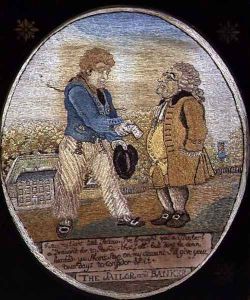Rowlandson,T.& Woodward,G.M. Paintings
Thomas Rowlandson, born in 1756 in London, England, and George Moutard Woodward, whose birth details are less known but believed to be around 1760, were prominent figures in the Georgian era of British satirical art. Rowlandson, renowned for his humorous and satirical illustrations, was a prolific artist whose work captured the follies and vices of society with a keen and often indulgent eye. Woodward, less known for his artistic skill than for his witty and often bawdy humor, collaborated frequently with Rowlandson, providing the latter with sketches and ideas to execute in print.
Rowlandson's education at the Royal Academy and his study of drawing at Paris laid a solid foundation for his artistic career. His talent flourished in the late 18th and early 19th centuries, a period marked by political upheaval and social change in Britain. Rowlandson's work, characterized by its vibrant watercolors and lively depiction of human character, ranged from social satires, caricatures, to picturesque scenes of everyday life. He had a remarkable ability to capture both the ridiculous and the sublime, making his work popular among a wide audience.
George Moutard Woodward's collaboration with Rowlandson was pivotal. Woodward, primarily known for his humorous and satirical writings, found in Rowlandson the ideal illustrator for his ideas. Together, they produced several notable works that critiqued and lampooned the politics, prominent figures, and social mores of the time. Their partnership was one of mutual benefit, with Woodward providing the conceptual and comic elements and Rowlandson bringing them to life with his artistic skill.
Despite the difference in their backgrounds and the less documented life of Woodward, their collaboration was significant in the landscape of British satire. Woodward died in 1809, leaving behind a legacy intertwined with Rowlandson's. Thomas Rowlandson continued to work and maintain his popularity until his death in 1827. The works of Rowlandson and Woodward remain valuable for their historical and artistic merit, offering insights into the societal concerns and cultural climate of Georgian England.
